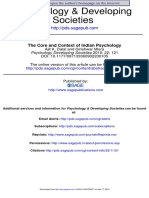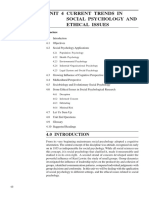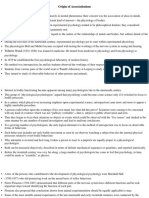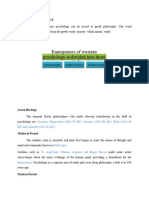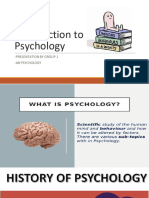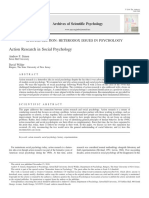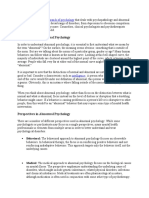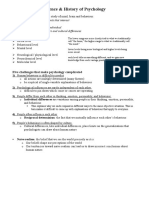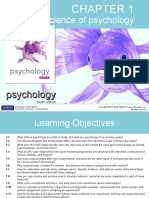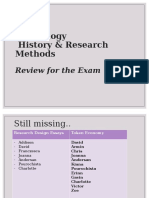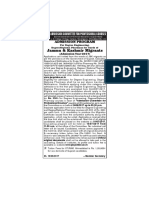Functionalism
American Psychology Takes Hold
�American functionalism
central interest: how the animal uses its mind to adapt to
environment
key tenets:
consciousness cannot be meaningfully analyzed in
elements
structure and function cannot be meaningfully separated
behavior should be treated in terms of significance to
the organism
fit with American temperament: individualism,
independence, pragmatism
move toward applied psychology embraced
Functionalism by Titchener
�William James
father of American Psychology
divisive figure:
heavy focus on mentalistic and psychical
(psychedelic) phenomena
religion, telepathy, seances, mind-altering drugs
not an experimentalist by trade (held positions in Psychology in
Philosophy department at Harvard)
concerned with the consequences of German mechanistic approach
disagreements with Wundt
not the founder of functional psychology per se, but ideas had huge
influence on American movement
�James program
in James we see the first clear articulation of views in
opposition to European tradition
elemental science v. holistic discipline
pure science v. pragmatic discipline
scientific and philosophic approaches
synthesis of evolutionary ideas
The principles of psychology (1890) - James
study of people as they adapt to their environment
consciousness has a function (enables survival)
espoused a radical empiricism
anything that can be observed is important for James
use of introspective and comparative methods
both mental processes and behavior are important
Psychology a briefer course (1892) - Jimmy
�James on pragmatism
Rationalism sticks to logic and the empyrean [lofty, abstract].
Empiricism sticks to the external senses. Pragmatism is willing to
take anything, to follow either logic or the senses and to count the
humblest and most personal experiences.
The corpus of the dispute was a squirrel a live squirrel supposed to be clinging to one
side of a tree-trunk; while over against the trees opposite side a human being was
imagined to stand. This human witness tries to get sight of the squirrel by moving
rapidly round the tree, but no matter how fast he goes, the squirrel moves as fast in the
opposite direction, and always keeps the tree between himself and the man, so that
never a glimpse of him is caught. The resultant metaphysical problem now is this: Does
the man go round the squirrel or not? He goes round the tree, sure enough, and the
squirrel is on the tree; but does he go round the squirrel?
The pragmatic method is primarily a method of settling metaphysical disputes that
otherwise might be interminable. Is the world one or many? fated or free? material or
spiritual? here are notions either of which may or may not hold good of the world; and
disputes over such notions are unending. The pragmatic method in such cases is to try to
interpret each notion by tracing its respective practical consequences.
the validity of an idea must be tested by
looking at its practical consequences*remember the Sophists
�the stream of consciousness
consciousness is a continuous flow, always changing, never the same twice.
consciousness is:
personal: makes no sense to look for general
principles (individual differences)
irreducible: cannot be divided up for analysis
makes no sense to look for elements
selective: certain events entering are attended to
and others are not
functional: serves to aid in survival of organism
�on habits and instincts
animal behavior is guided by instinct but
modified by experience, new instinct-like behaviors emerge
habits:
functional (reduce fatigue, resources, increase accuracy and reliability)
neurophysiological explanation for the formation of habits?
Alexander Bain
spontaneous behaviors arise and are associated
with positive or negative outcomes voluntary
For every act of memory, every exercise of
bodily aptitude, every habit, recollection, train of
ideas, there is a specific grouping, or coordination, of sensation and movements, by
virtue of specific growth in the cell junctions
�on the (empirical) self
everything that you can call your own
material: body, family, property
social: self as known by others
a man has as many social selves as there are
individuals that recognize him and carry an image of him
in their minds
spiritual: states of consciousness, the thinker
on esteem:
Success
esteem may be quantified: Pretensions
�on emotion
the James-Lange theory of emotion
reverses traditional causal relationship
Tehran (sees spider) Tehran (knows fear) Tehran (heart raises) Tehran (runs)
stimulus
responses
the physical response precedes emotion
bodily change is the emotion
ideo-motor theory:
idea and action are one in the same, idea flows immediately to action
- anticipated modern motor theory (repository of action ideas)
- by attending to idea (will) behavior is caused.
Embodiment is sexy today
idea - body - environment are one in the same
bodily events shape thoughts (*see Proffitt)
�Msterberg
James successor at Harvard
Applied psychology
study of abnormal behavior and mentally ill
treats addiction, phobia, dysfunction through
Reciprocal antagonism
forensic psychology: eyewitness testimony / objective test
On the Witness Stand
industrial psychology
methods of personnel selection, methods of
increasing work efficiency, and marketing and
advertising technique
�Whiton Calkins
first woman president of APA
first lab at a womens college (Wellesley)
significant contributions to research in: memory
objects v. contents of consciousness
developed paired-associate technique
importance of modality,
recency, vividness, and
frequency in memorization
negative recency effect
�G. Stanley Hall
Firsts:
American PhD in psychology
American lab in psychology
American journal in psychology
president of APA
president of Clark University
majority of early American PhDs
interests in human development and adolescence
new habits being formed
recapitulation theory
moral development
sublimation: tamp down ill sexual desires through work
I had never chanced again upon a book that seemed to me to degrade me in
my womanhood as the seventh and seventeenth chapters on women and
womens education of President G. Stanley Halls Adolescence
�Francis Cecil Sumner
first African American PhD
first head of dept. @ Howard U.
paradoxically advocates for segregated higher-ed
Inez Beverley Prosser
first African American Woman PhD
work influence Brown v. Board of Ed.
Kenneth and Mamie Phipps Clark
segregations negative impact of on children (of all races)
doll studies: black children identify
with and prefer white dolls
major efforts in desegregation
�Margaret Floy Washburn
The Animal Mind
first woman to receive her PhD in psych
second woman president of APA
student of Titchener
primarily interested in inferring
consciousness in animals at all phylogenetic
levels.
hundreds of experiments in such areas as sensory discrimination,
space perception, and learning ability (though focus was on
consciousness)
the ideal method of studying higher animal experience
�Thorndike
a bridge to behaviorism
comparative psychology: using animals to gain
understanding of the first principles of learning
before Thorndike:
are human and animal intelligence / emotion equivalent?
Morgans canon: in no case are we to interpret behavior as the result
of a higher order process if it can be interpreted at a lower scale
all behavior is purposive
Moved to Columbia (brought his 2 best chickens) and began puzzle
box experiments
research into trial and error learning
early research with chickens - bitter corn and maze escape
�instrumental conditioning
Trial and error turns to organized behavior
Learning is incremental and occurs automatically
The same applies to
ALL animals
�bridge to behaviorism
a new type of associationism
early advocate of S-R psychology
relationship between sensation and ideas?
relationship between ideas and ideas?
relationship between ideas and behavior?
relationship between stimulus and response
Thorndike is not a behaviorist proper:
included notions such as satisfactory outcome (mentalese)
saw some value in introspection


